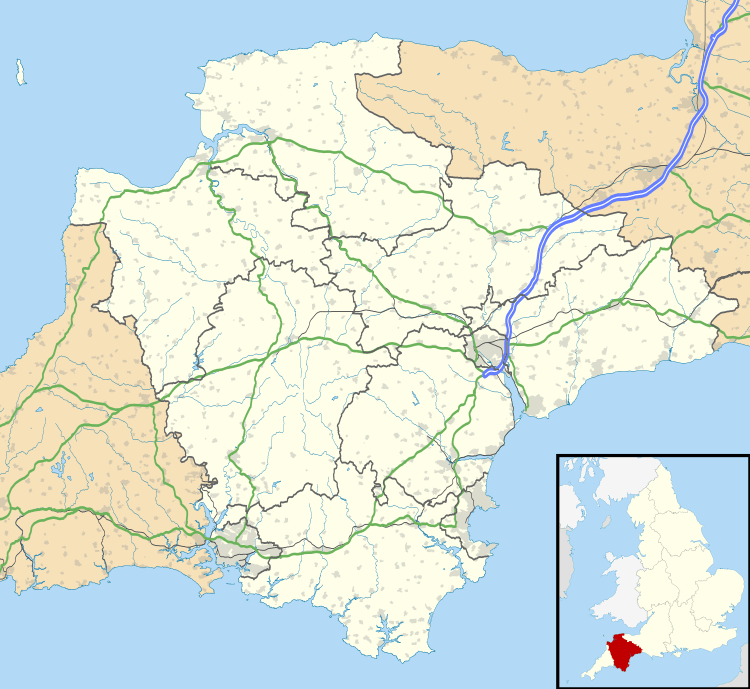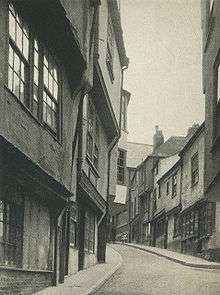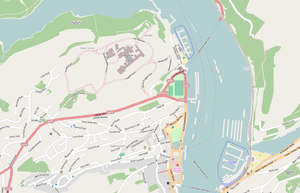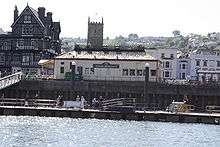Dartmouth, Devon
| Dartmouth | |
 Dartmouth from the River Dart |
|
 Dartmouth |
|
| Population | 5,064 (2011) |
|---|---|
| OS grid reference | SX877514 |
| Civil parish | Dartmouth |
| District | South Hams |
| Shire county | Devon |
| Region | South West |
| Country | England |
| Sovereign state | United Kingdom |
| Post town | DARTMOUTH |
| Postcode district | TQ6 |
| Dialling code | 01803 |
| Police | Devon and Cornwall |
| Fire | Devon and Somerset |
| Ambulance | South Western |
| EU Parliament | South West England |
| UK Parliament | Totnes |
Coordinates: 50°21′04″N 3°34′44″W / 50.351°N 3.579°W
Dartmouth is a town and civil parish in the English county of Devon. It is a tourist destination set on the western bank of the estuary of the River Dart, which is a long narrow tidal ria that runs inland as far as Totnes. It lies within the South Devon Area of Outstanding Natural Beauty and South Hams District, and had a population of 5,512 in 2001,[1] reducing to 5,064 at the 2011 census[2] There are two electoral wards in the Dartmouth area (Townstal & Kingswear). Their combined population at the above census was 6,822.[3][4]
History
Dartmouth was of strategic importance as a deep-water port for sailing vessels. The port was used as the sailing point for the Crusades of 1147 and 1190, and Warfleet Creek, close to Dartmouth Castle is supposed by some to be named for the vast fleets which assembled there.[5] Dartmouth was a home of the Royal Navy from the reign of Edward III and was twice surprised and sacked during the Hundred Years' War, after which the mouth of the estuary was closed every night with a great chain. The narrow mouth of the Dart is protected by two fortified castles, Dartmouth Castle and Kingswear Castle. Originally Dartmouth's only wharf was Bayard's Cove, a relatively small area protected by a fort at the southern end of the town.
In 1373 Geoffrey Chaucer visited and among the pilgrims in his Canterbury Tales
- A schipman was ther, wonyng fer by weste;
- For ought I wost, he was of Dertemouthe.
Notwithstanding Dartmouth's connections with the crown and respectable society, it was a major base for privateering in medieval times. John Hawley or Hauley,[6] a licensed privateer and sometime mayor of Dartmouth [7] is reputed to be a model for Chaucer's "schipman".
The earliest street in Dartmouth to be recorded by name (in the 13th century) is Smith Street. Several of the houses on the street are originally late 16th century or early 17th century and probably rebuilt on the site of earlier medieval dwellings. The street name undoubtedly derives from the smiths and shipwrights who built and repaired ships here when the tidal waters reached as far as this point. Smith Street was also the site of the town pillory in medieval times.

St Saviour's Church was constructed in 1335 and consecrated in 1372. It contains a pre-Reformation oak rood screen built in 1480 and several monuments including the tomb of John Hawley (d. 1408) and his two wives, covered with a large brass plate effigy of all three. A large medieval ironwork door is decorated with two leopards of the Plantagenets and is possibly the original portal. Although it is dated "1631", this is thought to be the date of a subsequent refurbishment coincidental with major renovations of the church in the 17th century.[8] The gallery of the church is decorated with the heraldic crests of prominent local families and is reputed to be constructed of timbers from ships captured during the defeat of the Spanish Armada,[9] although this has not been categorically substantiated.
In 1592 the Madre de Deus, a Portuguese treasure ship captured by the English in the Azores, docked at Dartmouth Harbour. It attracted all manner of traders, dealers, cutpurses and thieves and by the time Sir Walter Raleigh arrived to reclaim the Crown's share of the loot, a cargo estimated at half a million pounds had been reduced to £140,000.[10] Still, ten freighters were needed to carry the treasure to London.
Henry Hudson put in to Dartmouth on his return from North America, and was arrested for sailing under a foreign flag. The Pilgrim Fathers put in to Dartmouth's Bayard's Cove, en route from Southampton to America. They rested a while before setting off on their journey in the Mayflower and the Speedwell on 20 August 1620. About 300 miles west of Land's End, upon realising that the Speedwell was unseaworthy, it returned to Plymouth. The Mayflower departed alone to complete the crossing to Cape Cod. Dartmouth's sister city is Dartmouth, Massachusetts.

The town contains many medieval and Elizabethan streetscapes and is a patchwork of narrow lanes and stone stairways. A significant number of the historic buildings are listed.[11] One of the most obvious is the Butterwalk, built 1635 to 1640. Its intricately carved wooden fascia is supported on granite columns. Charles II held court in the Butterwalk whilst sheltering from storms in 1671 in a room which now forms part of Dartmouth Museum.[12] Much of the interior survives from that time.
The Royal Castle Hotel was built in 1639 on the then new quay. The building was re-fronted in the 19th century, and as the new frontage is itself listed, it is not possible to see the original which lies beneath. A claimant for the oldest building is a former merchant's house in Higher Street, now a Good Beer Guide listed public house called the Cherub, built circa 1380. Agincourt House (next to the Lower Ferry) is also 14th century.
Dartmouth sent numerous ships to join the English fleet that attacked the Spanish Armada, including the Roebuck, Crescent and Hart.[13] The Nuestra Señora del Rosario, the Spanish Armada's "payship" commanded by Admiral Pedro de Valdés, was captured along with all its crew by Sir Francis Drake. It was reportedly anchored in the River Dart for more than a year and the crew were used as labourers on the nearby Greenway Estate which was the home of Sir Humphrey Gilbert and his half-brother Sir Walter Raleigh. Greenway was later the home of Dame Agatha Christie.[14]
The remains of a fort at Gallants Bower just outside the town are some of the best preserved remains of a Civil War defensive structure.[15] The fort was built by Royalist occupation forces in c. 1643 to the south east of the town, with a similar fort at Mount Ridley on the opposite slopes of what is now Kingswear. The Parliamentarian General Fairfax attacked from the north in 1646, taking the town and forcing the Royalists to surrender, after which Gallants Bower was demolished.
19th century
The made-up embankment which today extends the whole length of the town's riverbank is the result of 19th century land reclamation, started in earnest when the town played host to a large number of prisoners of war from the Napoleonic Wars which formed a captive workforce. Before this, what is now the town centre was almost entirely tidal mud flats.
The Royal National Lifeboat Institution opened the Dart Lifeboat Station at the Sand Quay in 1878, but it was closed in 1896. In all this time only one effective rescue was made by the lifeboat.[16]
20th century

In the latter part of World War II the town was a base for American forces and one of the departure points for Utah Beach in the D Day landings. Slipways and harbour improvements were also constructed. Much of the surrounding countryside and notably Slapton Sands was closed to the public while it was used by US troops for practise landings and manoeuvres.
21st century
Dart Lifeboat Station was reopened in 2007, the first time that a lifeboat had been stationed in the town since 1896. It has initially been kept in a temporary building in Coronation Park.[16]
In 2010, a fire seriously damaged numerous historical properties in Fairfax Place and Higher Street. Several were Tudor and Grade I or Grade II listed buildings.[17]
Governance
The town was an ancient borough, incorporated by Edward III, known formally as Clifton-Dartmouth-Hardness, and consisting of the three parishes of St Petrox, St Saviour and Townstal, and incorporating the hamlets of Ford, Old Mill and Norton.[18] It was reformed under the Municipal Corporations Act 1835. The town returned two members of parliament from the 13th century until 1835, after which one MP was elected until the town was disenfranchised in 1868. It remained a municipal borough until 1974, when it was merged into the South Hams district, and became a successor parish of Dartmouth with a town council.[19][20]
Dartmouth Town Council is the lowest of three tiers of local government. It consists of 16 councillors representing the two wards of Clifton and Townstal.[21] At the second tier, Dartmouth forms part of the Dartmouth and Kingswear ward of South Hams District Council, which returns three councillors.[22] At the upper tier of local government Dartmouth and Kingswear Electoral Division elects one member to Devon County Council.[23]
Culture and tourism

The Port of Dartmouth Royal Regatta takes place annually over three days at the end of August. The event sees the traditional regatta boat races along with markets, fun fairs, community games, air displays including the Red Arrows and fireworks. A Royal Navy guard ship is present at the event.
Bayard's Cove has been used in several television productions, including The Onedin Line[24] a popular BBC television drama series that ran from 1971 to 1980. Many of the scenes from the BBC's popular series 'Down to Earth', starring Ricky Tomlinson, were filmed at various locations around the town.[25]
Notable tourist attractions include the Dartmouth Royal Naval College, Dartmouth Castle and the Dartmouth Steam Railway which terminates at Kingswear on the opposite bank of the river.
Boat cruises to nearby places along the coast (such as Torbay and Salcombe) and up the river (to Totnes, Dittisham and the Greenway Estate) are provided by several companies. The paddlesteamer PS Kingswear Castle returned to the town in 2013.[26]
Climate
The nearest Met Office weather station is Slapton, about 5 miles south-south west of Dartmouth and a similar distance from the coast. As with the rest of the British Isles and South West England, the area experiences a maritime climate with warm summers and mild winters - this is particularly pronounced due to its position near the coast - extremes range from a record low of just −8.0 °C (17.6 °F) in January 1987[27] up to a record high of 30.5 °C (86.9 °F) during June 1976.[28]
| Climate data for Slapton, 1981-2010, Extremes 1960- | |||||||||||||
|---|---|---|---|---|---|---|---|---|---|---|---|---|---|
| Month | Jan | Feb | Mar | Apr | May | Jun | Jul | Aug | Sep | Oct | Nov | Dec | Year |
| Record high °C (°F) | 14.6 (58.3) |
14.5 (58.1) |
19.5 (67.1) |
20.5 (68.9) |
24.0 (75.2) |
30.5 (86.9) |
28.0 (82.4) |
28.5 (83.3) |
25.0 (77) |
21.9 (71.4) |
17.7 (63.9) |
15.5 (59.9) |
30.5 (86.9) |
| Average high °C (°F) | 9.2 (48.6) |
9.1 (48.4) |
10.8 (51.4) |
12.8 (55) |
15.7 (60.3) |
18.6 (65.5) |
20.7 (69.3) |
20.7 (69.3) |
18.5 (65.3) |
15.2 (59.4) |
12.0 (53.6) |
9.8 (49.6) |
14.5 (58.1) |
| Average low °C (°F) | 3.8 (38.8) |
3.5 (38.3) |
4.8 (40.6) |
5.6 (42.1) |
8.4 (47.1) |
10.6 (51.1) |
12.8 (55) |
13.0 (55.4) |
11.4 (52.5) |
9.3 (48.7) |
6.4 (43.5) |
4.4 (39.9) |
7.9 (46.2) |
| Record low °C (°F) | −8.0 (17.6) |
−6.8 (19.8) |
−6.5 (20.3) |
−2.5 (27.5) |
−0.1 (31.8) |
2.6 (36.7) |
6.2 (43.2) |
6.1 (43) |
3.9 (39) |
0.2 (32.4) |
−2.2 (28) |
−4.5 (23.9) |
−8 (18) |
| Average precipitation mm (inches) | 124 (4.88) |
94 (3.7) |
90 (3.54) |
70 (2.76) |
67 (2.64) |
61 (2.4) |
64 (2.52) |
66 (2.6) |
72 (2.83) |
114 (4.49) |
119 (4.69) |
134 (5.28) |
1,075 (42.33) |
| Mean monthly sunshine hours | 58 | 76 | 119 | 181 | 211 | 214 | 216 | 198 | 155 | 102 | 75 | 48 | 1,653 |
| Source: Met Office | |||||||||||||
Transport
Dartmouth is linked to Kingswear, on the other side of the River Dart, by three ferries. The Higher Ferry and the Lower Ferry are both vehicular ferries. The Passenger Ferry, as its name suggests, carries only passengers, principally to connect with the Paignton and Dartmouth Steam Railway at Kingswear station. The nearest bridge across the Dart is in Totnes, some 11 miles (18 km) away by road.[29]

The A379 road runs through Dartmouth, linking the town to Slapton and Kingsbridge to the southwest and to Torbay to the east across the Higher Ferry. The A3122 connects Dartmouth to a junction with the A381, and hence to both Totnes and a more direct route to Kingsbridge. First South West provides local town bus services and links to, Plymouth, Kingsbridge. As well as Stagecoach Gold provides a luxury bus service to Torquay via Totnes and Paignton. In addition Stagecoach Devon provides links to the Torbay resorts of Brixham, Paignton and Torquay from Kingswear via the ferry.
No railway has ever run to Dartmouth, but the town does have a railway station,[30] although it is now a restaurant. The railway line to Kingswear was opened in 1864, the original plans for the Dartmouth and Torbay Railway line took the line across a bridge and into the town. Opposition from local seamen and merchants saw the route diverted to Kingswear on the opposite side of the river, but this occurred after the station had been built at Dartmouth. The railway terminated at a station called "Kingswear for Dartmouth" (now on the Paignton and Dartmouth Steam Railway) and a ferry took passengers across the river to the station at Dartmouth railway station, which had a dedicated pontoon. British Railways closed the line to mainline passenger trains in 1973, but it re-opened as a heritage line and has run as one ever since.

Education
Royal Naval College
The town is home to the Royal Navy's officer training college (Britannia Royal Naval College), where all officers of the Royal Navy and many foreign naval officers are trained.
Schools
Dartmouth has one secondary school — formerly (Dartmouth Community College) now Dartmouth Academy — an all-through school for those aged 3–18, and two primary schools: (Dartmouth Primary school (now part of Dartmouth Academy) and St John the Baptist R.C. Primary School). Dartmouth Community College and Dartmouth Primary School are part of the Dartmouth Learning Campus; as from September 2007, Dartmouth Community College is part of a federation with Dartmouth Primary School and Nursery, meaning that the two schools share one governing body for pupils aged 1 to 19. Dartmouth also has a pre-school in the centre of town, established for over 40 years and based in the old Victorian school rooms at South Ford Road. It provides care for 2- to 5-year-olds and is run as a charitable organisation.
Sport and leisure
Dartmouth has a Non-League football club Dartmouth A.F.C. who play at Long Cross.
Dartmouth also hosts the annual "World Indoor Rally Championship", based on Slot car racing in the late summer.[31][32]
At the end of August and early September there is the annual Port of Dartmouth Royal Regatta.
Since 1905 Dartmouth has had a greenhouse as part of the Royal Avenue Gardens.[33][34] In May 2013 this building, used for the previous 10 years by Dartmouth in Bloom,[35] a not-for-profit organisation affiliated with Britain in Bloom, was closed as structurally unsound.[36] There are proposals to restore the greenhouse to its prior Edwardian style.[37]
Notable residents
Thomas Newcomen, the inventor of the atmospheric engine – the first successful steam-powered pumping engine – was born in Dartmouth in 1663. The location of his house in Lower Street is marked with a plaque, although the building itself was demolished (and elements incorporated into local architect Thomas Lidstone's house on Ridge Hill) in the 19th century to make way for a new road which was named after Newcomen. An 18th-century working Newcomen steam engine is on display in the town.
The town was home to the civil engineer and calculating prodigy George Parker Bidder (1806–1878), who is notable for his work on railways over much of the world, as well as the docks of the East End in the Port of London. Bidder served on the town council, and his expertise was instrumental in draining the area which is now the centre of the town. He also undertook pioneering work with Samuel Lake on steam trawling whilst living in the town. Bidder died at his home at Paradise Point near Warfleet Creek and is buried at nearby Stoke Fleming.
Flora Thompson lived in Above Town between 1928 and 1940, writing Lark Rise and Over to Candleford during this time. The books were later combined into a single volume with the later Candleford Green to form the well-known Lark Rise to Candleford. She is buried at Longcross Cemetery.
The stage and film actress Rachel Kempson (1910–2003) was born in Dartmouth. She was the wife of Sir Michael Redgrave and mother of Vanessa, Lynn and Corin, and published her autobiography, Life Among the Redgraves, in 1988.
Gordon Onslow Ford (1912–2003), a leading British surrealist painter, attended the Royal Naval College.
Sir John Harvey Jones (1924-2008), Businessman and television presenter, attended the Royal Naval College.
Christopher Robin Milne, son of A.A. Milne, after whom the character Christopher Robin in the Winnie-the-Pooh books was named, used to own the Harbour Bookshop. The bookshop was reported as facing closure in September 2011[38] and the report was fulfilled.
Many local businesses were commemorated in a special edition of the card game Happy Families produced locally in 1987,[39] created to raise funds locally. A copy is held in Dartmouth Museum.[40]
Theodore Veale, recipient of the Victoria Cross during the First World War.
References
- ↑ Office for National Statistics : Census 2001 : Parish Headcounts : South Hams Retrieved 27 January 2010
- ↑ "Parish population 2011". Retrieved 19 February 2015.
- ↑ "Dartmouth and Kingswear ward 2011". Retrieved 19 February 2015.
- ↑ "Dartmouth Townstall ward 2011". Retrieved 19 February 2015.
- ↑ "What's in A Name - Warfleet Creek". By The Dart. Retrieved 10 July 2016.
- ↑ "John Hawley of Dartmouth". Devonperspectives.co.uk. 11 February 2012. Retrieved 25 October 2012.
- ↑ "Roll Of Mayoralty". Dartmouth-history.org.uk. Retrieved 25 October 2012.
- ↑ "St Saviour, Dartmouth, Devon - Church". Roughwood.net. 27 February 2009. Retrieved 25 October 2012.
- ↑ Andrews, Robert (2013). The Rough Guide to Devon & Cornwall. Rough Guides UK. ISBN 9781409364863.
- ↑ McDermott, James (2001). Martin Frobisher: Elizabethan Privateer. Yale University Press. pp. 397–398. ISBN 9780300083804.
- ↑ Good Stuff IT Services. "Listed Buildings in Dartmouth, Devon, England". British Listed Buildings. Retrieved 25 October 2012.
- ↑ "The King's Room at Dartmouth Museum". Dartmouth Museum. Retrieved 29 July 2011.
It was in this magnificent room that King Charles II was entertained in July 1671, when storms forced him to seek shelter in Dartmouth.
- ↑ Russell, Percy (September 1946). Ancient Dartmouth (PDF). Retrieved 2 February 2013.
- ↑ "Dartmouth, Devon - Destinations UK". Historic-uk.com. 4 June 1944. Retrieved 25 October 2012.
- ↑ "Gallants Bower". National Trust. Retrieved 10 July 2016.
- 1 2 Leach, Nicholas (2009). Devon's Lifeboat Heritage. Chacewater: Twelveheads Press. pp. 19–20. ISBN 978-0-906294-72-7.
- ↑ "Dartmouth's Tudor buildings destroyed by chip shop fire". BBC News. 29 May 2010. Retrieved 30 May 2010.
- ↑ Pigot & Co.'s Devonshire (1830) GenUKi
- ↑ The English Non-metropolitan Districts (Definition) Order 1972 (S.I. 1972 No. 2039)
- ↑ The Local Government (Successor Parishes) Order 1973 (S.I. 1973 No. 1110)
- ↑ Dartmouth Town Councillors, Dartmouth Town Council. Retrieved 21 March 2008
- ↑ "Election of District Councillors for Dartmouth and Kingswer" (PDF). South Hams District Council. Retrieved 15 April 2011.
- ↑ Division 36: Dartmouth and Kingswear, Devon County Council. Retrieved 21 March 2008
- ↑ "Things to Do - Indoor - Outdoor - Dartmouth Museum". Dartmouth Museum. Retrieved 19 August 2011.
Bayards Cove was used in the BBC period drama The Onedin Line to represent the wharves and buildings of Liverpool Docks.
- ↑ http://www.dartmouth.tv/ig-dartmouth/dmi-0005.htm
- ↑ "Paddlesteamer Kingswear Castle returns home to the Dart after 50 years". Western Morning News. 8 December 2012. Retrieved 18 December 2012.
- ↑ "1987 temperature". KNMI.
- ↑ "1976 temperature". KNMI.
- ↑ "Dart Harbour : Ferries". The Dart Harbour and Navigation Authority. Retrieved 18 September 2008.
- ↑ "Heritage, Landscape & Wildlife: Dartmouth Town Trail". South Devon AONB. Retrieved 25 October 2012.
- ↑ http://www.slotforum.com/forums/index.php?showtopic=56804
- ↑ https://www.youtube.com/watch?v=rSaiaCDqIvs
- ↑ "History of Dartmouth Community Greenhouse". Dartmouth in Bloom. Retrieved 17 May 2013.
The Dartmouth Greenhouse was built in 1905. This Greenhouse is part of the history of Royal Avenue Gardens and part of the heritage of the town of Dartmouth.
- ↑ "Bloom team bid to restore greenhouse". North London Today. Tindle Newspapers. 15 March 2013. Retrieved 17 May 2013.
The greenhouse, built in 1905, was an original feature of the New Ground, which became Royal Avenue Gardens, and remains the oldest surviving feature of the gardens, six years older than the bandstand.
- ↑ "Dartmouth in Bloom, horticultural achievement, environmental responsibility, community participation Dartmouth in Bloom". Dartmouth in Bloom. Retrieved 6 October 2013.
- ↑ "Bloom contest fear over gardening cut". Dartmouth Chronicle. Tindle Newspapers. 3 May 2013. Retrieved 17 May 2013.
... the local bloom team has had to cope with the closure of its community Greenhouse which has been deemed too structurally dangerous to use.
- ↑ "Bloom team bid to restore greenhouse". Dartmouth Chronicle. Tindle Newspapers. 15 March 2013. Retrieved 17 May 2013.
Dartmouth in Bloom has big plans to rescue one of the town’s greatest assets, the community greenhouse, and restore it to its former Edwardian glory. The move comes at a time when the future of the community greenhouse is at risk, with controversial proposals from South Hams Council, which owns the building, to flatten it to extend the Mayor Avenue car park.
- ↑ "BBC News - Christopher Robin's Dartmouth bookshop to close". bbc.co.uk. 19 August 2011. Retrieved 25 October 2012.
- ↑ "visually lush: Dartmouth Happy Families". Lydiadimitrova.blogspot.co.uk. 7 May 2009. Retrieved 25 October 2012.
- ↑ "Holdsworth Room - War - Peace - Oldstone Dolls House - Dartmouth Museum". Dartmouth Museum. Retrieved 23 July 2012.
In one of the many drawers [...] you will find a very special pack of cards; Dartmouth's own local Happy Families game, devised by local artist Simon Drew and sold in 1987 to raise money for the swimming pool fund.
External links
| Wikimedia Commons has media related to Dartmouth, Devon. |
| Wikivoyage has a travel guide for Dartmouth. |
- Dartmouth at DMOZ
- Charles Oman, "Dartmouth and Kingswear Castles: Twin Dart estuary defenders"
- Dartmouth Museum
- Dartmouth WebCam
-
 "Dartmouth". The American Cyclopædia. 1879.
"Dartmouth". The American Cyclopædia. 1879.
-
 "Dartmouth, a seaport, market town, and municipal borough in the Torquay parliamentary division of Devonshire, England". Encyclopædia Britannica (11th ed.). 1911.
"Dartmouth, a seaport, market town, and municipal borough in the Torquay parliamentary division of Devonshire, England". Encyclopædia Britannica (11th ed.). 1911.